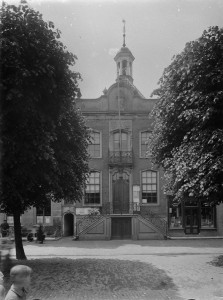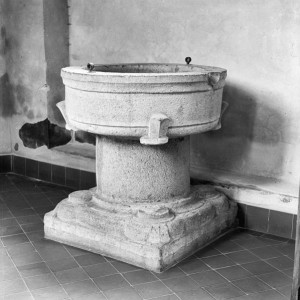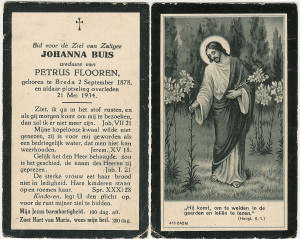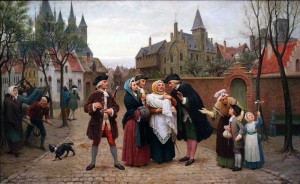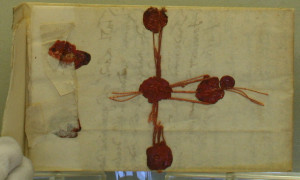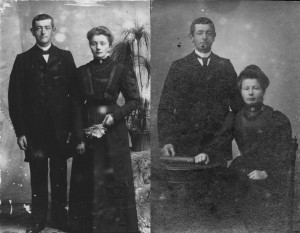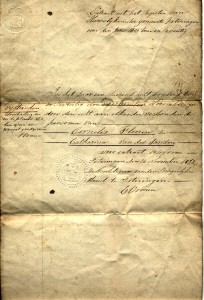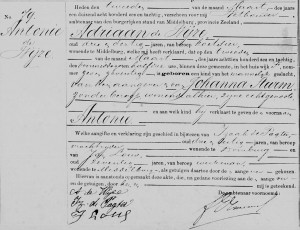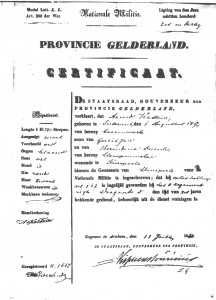In the days before the introduction of the civil registration in 1811 (or slightly earlier in Limburg and Zeeuws-Vlaanderen), the only legally recognized marriages were those performed before the court or by the Dutch Reformed church. Roman-Catholic couples usually married in the Roman-Catholic church as well. Be sure to always check both types of records because one may include more information than the other, as the following example will illustrate. Roman-Catholic marriage record This … [Read more...]
Archives for October 2013
Dutch term: Dopen
The Dutch word dopen means baptisms or to baptize. Doopboeken (baptize books) are the main source for birth information prior to the introduction of the civil registration (in 1811 for most of the Netherlands but as early as 1796/1797 for Limburg and Zeeuws-Vlaanderen). … [Read more...]
Source: prayer cards
I vividly remember the first time I visited the Central Bureau for Genealogy in The Hague. I must have been about sixteen years old, and had just started doing genealogy. My mom also became interested and went with me. When we checked the catalog, we found that there was an envelope with prayer cards of people named Flooren, my grandmother's maiden name. Within minutes, we held the prayer card of Petrus Flooren, my three-times-great-grandfather. My mom and I were very excited about this find. … [Read more...]
Quick tip: know the witnesses
Understanding who the witnesses in records were can help you find your ancestors. Baptism witnesses were usually chosen from the immediate family, often from siblings of the parents. Witnesses or informants for death records, on the other hand, were often neighbors. Knowing these customs can help you understand who these people were and how they fit into the picture you're creating about your ancestor. … [Read more...]
Dutch term: testament
A testament is a last will. Most people did not have a last will and died intestate. Usually, only wealthier people had a will drawn up. Wills can be found in notarial records or in court records (before 1811 in areas that did not have notaries). … [Read more...]
Ask Yvette: English version of WieWasWie?
Many people have asked me if there is an English version of WieWasWie, the website with the largest index of genealogical records in the Netherlands. WieWasWie is a joint project in which many different archives participate. Volunteers enter the information. In some cases, scans are also available. The website is the successor of the very popular Genlias website, that is no longer available. Unlike Genlias, WieWasWie does not have an English version. I recently attended a presentation about … [Read more...]
Quick tip: royal dispensations
Until 1939, it was forbidden to marry your sister-in-law or brother-in-law. Royal dispensation was required for such a marriage. Many widowed men who wanted to marry their deceased wife's sister applied for a dispensation. They were routinely granted, as in the case of my great-grandparents. Extracts of the royal dispensations can be found in the marriage supplements. … [Read more...]
Dutch term: Trouwboekje
A trouwboekje is a booklet that the bride and groom were issued at the time of their marriage. It lists their names, date and place of marriage and has room to add all of their children. It was referred to often when people needed to prove their identity. Read more about marriage booklets and the implications for your research. … [Read more...]
Ask Yvette: how to find my grandparents’ birth records
In response to an article about different types of archives, Larry Joosse wrote: Looking for birth records for Anthonie de Wijze born March 2, 1886 in Zand, and Catharina Johanna vanKeulen born on July 16, 1888. they are my mother’s parents. I thought I would respond in the form of a blog post and show you all the different steps that I take to find the answer. The methods I use to answer this question may also be helpful in finding your own ancestors. Step 1: assess the information Whenever … [Read more...]
Quick tip: Find out what your ancestor looked like
In the marriage supplements, the documents that a bride and groom had to submit when they got married, you will usually encounter a certificate stating that the groom had fulfilled his military duties. About half the time, this form will include a physical description. See elsewhere on this site for a list of terms with their translations. The example below is the certificate for Arend Kastein, showing that he was 1.74 m (5'9") tall, an oval face, ordinary stern, blue eyes, an ordinary nose and … [Read more...]
